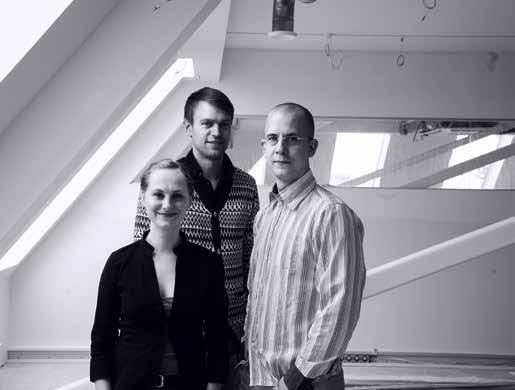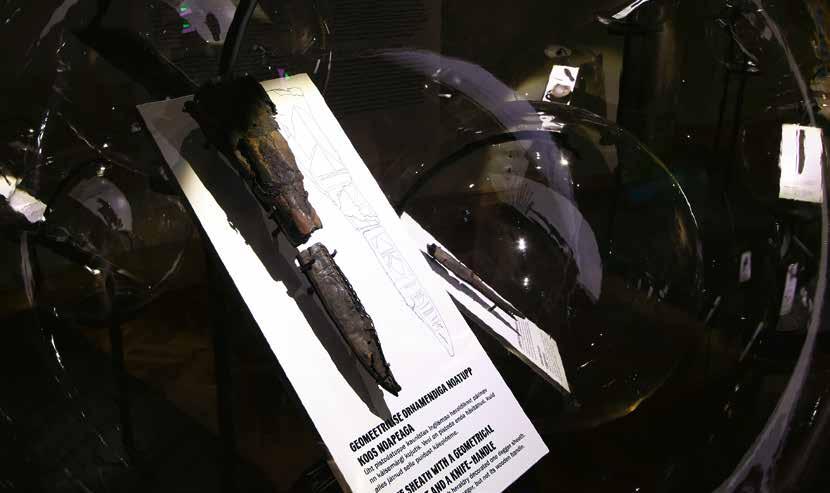
5 minute read
VETTPIdAVAd ALLIKAd”
from RUUMIPILT 2012
ruumilabor on loovbüroo, mille asutajateks on sisearhitektid janno Roos ja Andres Labi. Tänaseks on loodud bürookeskkondi, riigiasutuste esindusruume, hotelle, mitmeid kauplusi, kohvikuid ja restorane ning innovatiivseid näitusekujundusi. ruumilabori kaasabil valmis Eesti paviljoni projekt EXPo maailmanäitusele Shanghais.
Ruumilabor is a creative bureau, the founders of which are the interior architects Janno Roos and Andres Labi. By now they have created office environments, official rooms for governmental institutions, hotels, several shops, cafés and restaurants, and innovative exhibition designs. The Estonian pavilion project for the EXPO world exhibition in Shanghai was completed with the cooperation of Ruumilabor.
Advertisement
www.ruumilabor.ee
“watErtight sourcEs”
aadress/address: autorid/authors:
kuraator/curator: tellija/client: graafiline disain/ graphical design: teostus/implementation:
fotod/photos:
Pikk 17, Tallinn janno Roos, Andres Labi (Ruumilabor) Krista Sarv Eesti Ajaloomuuseum
Identity Tederdisain
Ruumilabor

väga hea näitus, efektne, ilma et oleks labane. Elegantselt leitud õige rakurss!
Leele Välja, arhitektuuriloolane

Ajaloomuuseumi ei ole tallinlasel just tihti asja. Siiski on põhjust aeg-ajalt asja teha. Lisaks hiljaaegu valminud muuseumi uuele kaasaegsele püsiekspositsioonile toimub seal haaravaid pisinäitusi, mille otsa komistada.
Mida seal eksponeeritakse ja kuidas tekkis näitusele ruum?
Janno Roos (JR): Lugu on lihtne: leiti üks varalaegas (13. sajandist) ehk ühe rändkaupmehe reisikast, unikaalne leid Põhja-Euroopa mastaabis, sellest ajast nii kompleksset kogumit esemeid ei olegi leitud. Tegemist on allveeuuringute käigus leituga. Tahtsime näitusega edasi anda meeleolu kesk sadu aastaid vee all vedelenud kola, saavutada suhteliselt toretsevas näituseruumis vaoshoitud ja väljapeetud tunnetus. Leitud on kastitäis asju – killud ja mündid, noatuped, kaaluvihid, sisuliselt „kontoritarbed”. Läänemeres on nähtavus vaid paarkolm meetrit, nii et selline haruldane leid. Andres Labi (AL): asju oli veel – muudel perioodidel leitud, väga erinevaid – kuidas võtta seda kokku ühise nimetajaga? JR: Inspireerisid õhumullid vees. Võtsime aluseks kupli (tegelikkuses tänavavalgustikuppel) ja eksponeerisime kõik esemed eraldi mulli sees, justkui konserveeritud. ruumi tegime hämaraks, lõime saarekesed, kus mullid on oma sisemise valgustusega või ka valgusvihk peale suunatud. AL: Enamik asju olid väikesed, mahtusid hästi mulli sisse, et ei saaks neid katsuda. JR: Lisaks on luup, et saaks münte uurida. Tollest ajast maalitud maakaart, mille suurendasime seinale. See on võrdlemisi abstraktne, kus pooled riigid ja mandrid on kummalisel kohal, mõndagi on puudu.
Kas Ajaloomuuseumis toimus modernne vastandumine või pigem sulandumine?
AL: Pigem ikka sulandumine, me saavutasime meremuuseumi feeling’u. asjad, mida eksponeerisime, on peaaegu samast ajast, kui maja. Mull eristab autentset ruumi ja samast ajast pärinevat eset, allegooriline seos tekib, mull loob mingi konteksti. ruum on jõuline ja jutukas. Sellest ei tohiks näitust kujundades üle karjuda, see ongi üks lähtekoht: kui ruum on tugeva loomuga, peaks kujundus olema tundlik, et mitte loomulikku keskkonda lõhkuda. Valus on midagi lisada, mis lõhub.
Siin ruumis on õhku. Mida tellija ootas? JR: oleme ajaloomuuseumile viis-kuus näitust kujundanud, eks me juba tunneme üksteist. Nende soov oli, et püsiksime teemas ja eelarves ning looksime turvalise ekspositsiooni, et see säiliks.
Siin on sulnis ja rahulik. Kas tööprotsess on ka pigem puhkuse moodi? AL: on pigem nagu palgata puhkus – hea võimalus stambist välja astuda. Ma imetlen Inga raukase näitusekujundusi, mis on hästi teravad ja täpsed. Näitus on pretensioonikam kui interjöör, tal ei ole otsest kasutajat. Suhtun ise kriitilisemalt näituseprojekti, see on nagu kunstiprojekt, kontseptsioonipõhine.
Tallinners do not often have motivation to go to the History Museum. There is nevertheless reason to go there from time to time. In addition to the museum’s new contemporary permanent exhibition that was recently completed, absorbing mini-exhibitions are held there that you can stumble onto.
What is on display there and how did the space for the exhibition come about? Janno Roos (JR): The story is simple: a treasure chest (from the 13th century) or the travelling trunk of a travelling merchant was found, a unique find on the scale of Northern Europe. Such a complete collection of objects has not previously been found from that era. It was found in the course of an underwater investigation. We wanted to convey the mood amidst junk that had been lying around under water for hundreds of years, to achieve a restrained and sustained feeling in a relatively luxurious exhibition space. A chest full of things has been found – fragments and coins, knife sheaths, weights, basically “office supplies”. Visibility in the Baltic Sea is only a couple of metres, so this kind of find is exceptional. Andres Labi (AL): There were other things as well – very different items found in different periods – how can all this be summed up under a common denominator? JR: Air bubbles in water inspired us. We adopted the globe as the basis (actually the globe of a streetlight) and displayed all the objects separately in bubbles, as if they were conserved. We made the room dim and created little islands where bubbles are lighted internally or by a beam of light. AL: Most of the objects were small and fit into the bubbles well, so that they could not be touched. JR: There is also a magnifying glass for examining the coins. And a map painted in that era that we enlarged and hung on the wall. It is relatively abstract, half the countries and continents are in strange places, and some places are missing altogether.
Was this a case of modern contrasting or more of amalgamation at the History Museum? AL: It was more amalgamation. We achieved the feeling of the Maritime Museum. The objects that we displayed are almost from the same time as the building itself. The bubble sets the authentic room apart from the object from the same era. An allegorical connection is created. The bubble creates a kind of context. The room is powerful and communicative. One should not drown it out with shouting when designing the exhibition, that is one point of departure: if the room has a strong character, the design should be sensitive in order to not destroy the natural environment. It is painful to add something that destroys.
There’s air in this room. What was the customer expecting? JR: We have designed five or six exhibitions for the History Museum, so we already know each other. They wanted us to stick to the theme and the budget while creating a safe exposition, so that it would be preserved.
It is delightful and peaceful here. Is the work process also more like a vacation? AL: It’s more like a vacation without pay – a good opportunity to shake off clichés. I admire the exhibition designs of Inga Raukas. They are very sharp and precise. The exhibition is more pretentious than the interior. It doesn’t have a direct user. I myself relate more critically to the exhibition project. It’s like an art project, concept-based.
Very good exhibition, impressive without being trite. The right angle found elegantly!
Leele Välja, historian of architecture











